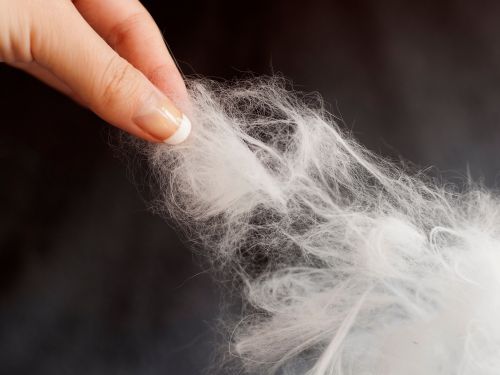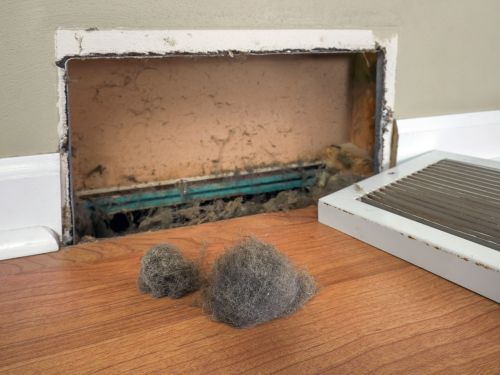Pet Hair, Dander, and Your Air Ducts: What Homeowners Should Know
Pets bring companionship, comfort, and joy to millions of households—but they also bring hair, dander, and dust that can accumulate inside your HVAC system over time. Many homeowners don’t realize how significantly pets impact the cleanliness of their air ducts and, ultimately, the quality of air circulating throughout their home. Understanding how pet-related debris affects your HVAC system can help you create a healthier indoor environment and reduce the strain on your heating and cooling equipment.
This guide breaks down how pet hair and dander travel through your HVAC system, why they build up in the ducts, and what steps you can take to minimize future accumulation.


Need to Have Your Air Ducts Serviced?
How Pet Hair and Dander Affect Air Duct Cleanliness
Pets naturally shed hair and microscopic skin flakes known as dander. Both of these materials easily become airborne as pets move, scratch, or shed. Once in the air, they are pulled into the HVAC system and distributed throughout your ductwork.
Increased Debris in the System
Pet hair and dander accumulate quickly. Unlike household dust, pet hair is heavier and more fibrous, causing it to tangle and stick to surfaces inside ducts. Over time, this results in thick layers of debris that block airflow and reduce HVAC efficiency.
Clogged Air Filters
Filters designed to catch dust and small particles can become overwhelmed when exposed to large amounts of pet hair. When a filter clogs, the system must work harder to pull in air, which can increase energy use and lead to overheating.
Higher Allergen Levels
Pet dander is a well-known allergen that can irritate sensitive individuals. When dander collects in your ductwork, it recirculates throughout the home with every heating or cooling cycle, triggering sneezing, itchiness, or respiratory discomfort.
Increased Dust and Odors
Pet-related contaminants often contribute to musty or “pet-like” odors coming from HVAC vents. Ducts filled with dander and hair can also cause dust to settle more quickly on furniture and surfaces.
Why Your HVAC System Attracts Pet Hair and Dander
Several factors make HVAC systems a magnet for pet-related debris:
Airflow Direction
Your HVAC system constantly pulls air toward the return vents. Any loose hair or dander in the home is naturally drawn into the system.
Humidity and Moisture
Moisture inside ducts—especially near evaporator coils—traps hair and dander more easily. This mixture can become a breeding ground for bacteria and even mold.
Static Electricity
Electrostatic charges inside plastic or metal ductwork attract lightweight particles, causing them to cling to the interior surfaces of the ducts.
Strategies to Minimize Pet Hair and Dander Buildup in Air Ducts
Keeping your ducts clean when you have pets requires consistent maintenance and attention to air quality. Here are some effective ways to reduce buildup:
Change Air Filters More Frequently
Pet owners should change filters every 30–60 days, depending on shedding levels and filter type. High-MERV or HEPA-style filters can capture more pet dander and fine particles.
Use Pet-Friendly Air Purifiers
Air purifiers placed near pet resting or grooming areas reduce the amount of airborne hair and dander that enters the HVAC system.
Groom Pets Regularly
Routine brushing reduces shedding and minimizes loose hair circulating through the home. Pets with thicker coats may require more frequent grooming or seasonal deshedding treatments.
Vacuum and Dust More Often
Using vacuums with HEPA filtration helps remove dander from carpets, rugs, and upholstery. Clean floors, furniture, and vents frequently to prevent hair from gathering and traveling into the system.
Seal Duct Leaks
Leaks in the duct system can pull additional debris from attics, basements, or crawl spaces. Sealing gaps and cracks helps prevent unwanted contaminants from entering the system.
Schedule Professional Air Duct Cleaning
A professional duct cleaning service removes built-up pet hair, dander, and dust that standard cleaning cannot reach. Homes with multiple pets or heavy shedders may benefit from more frequent cleanings.
Maintain Healthy Indoor Humidity
Keeping indoor humidity levels between 30%–50% reduces static and helps prevent particles from sticking inside ducts.
Keep Your Air Ducts Clean—Protect Your Home and Your Pets
Pets are part of the family, but their shedding can affect your home’s air quality and the efficiency of your HVAC system. By understanding how pet hair and dander accumulate in air ducts and taking steps to minimize buildup, you can improve your indoor air quality and create a healthier living environment for your entire household.
Ready to restore clean, fresh air to your home? Contact Better Air Northwest today to schedule an inspection and keep your HVAC system running at its best.

